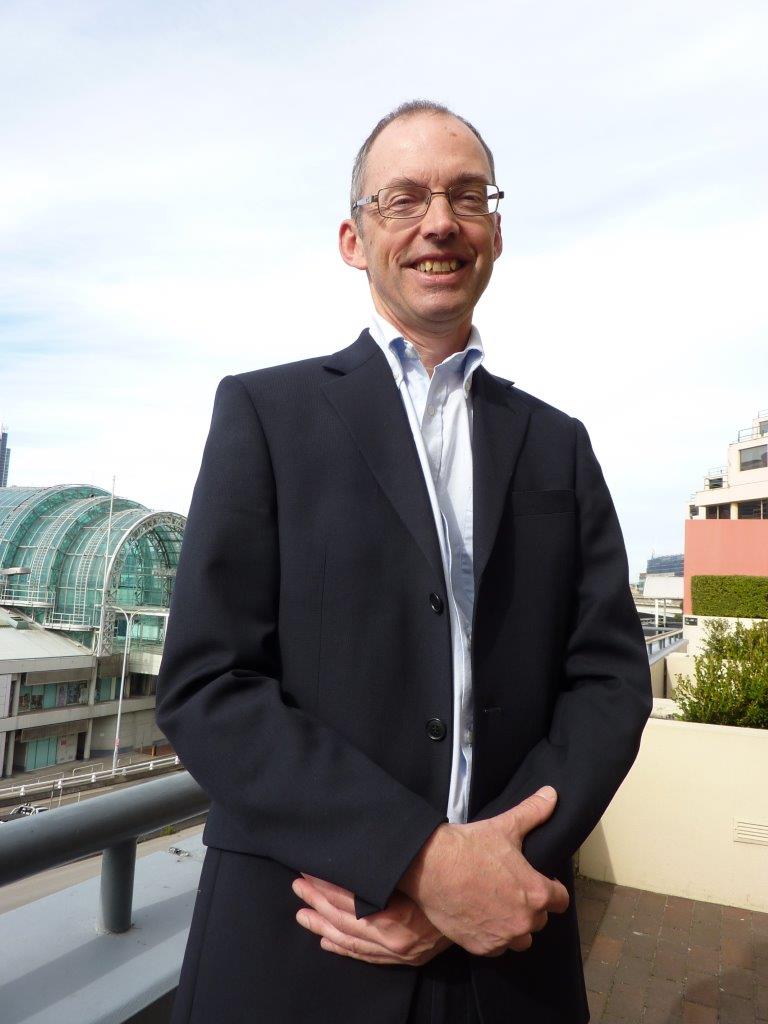IndigoVision is one of IP video’s heroic explorers. According to CEO Marcus Kneen, the company’s survival through the fierce landscape of the digital transition has depended on the brilliance of its solutions and the team’s commitment to each other and to customers.
MARCUS Kneen, IndigoVision’s CEO, is a zealous touring cyclist and sea-kayaker and his love of elemental challenges that pivot on dependable gear, careful logistics, and a combination of teamwork and self-reliance, says much about the nature of the man. At the end of our chat when Kneen tells me one of his heroes is legendary Australian Antarctic explorer, scientist and academic, Douglas Mawson; I’m not surprised. The consummate team leader, Mawson refused to quit, even when he believed he could not survive.
Formerly the company’s CFO, Kneen comes from the finance side but talking with him it’s easy to see why he’s running the show at IndigoVision. Kneen is technically very solid and he has an intensely holistic sense of what IndigoVision’s solutions mean for integrators and end users. For Kneen, they are physical manifestations of the company’s commitment to its customers.
From the moment we start talking Kneen doesn’t use the first person pronoun once in an hour and 15 minutes. I can rarely hold out more than 3 paragraphs. And while he’s genuinely self effacing, there’s raw passion under the surface. It comes out most strongly when he starts talking about values. When Kneen talks about integrity and loyalty to team and customer something in his tone and face makes you instantly aware he’s projecting things most central to his own character.
JA: How is the IndigoVision business going right now – where are you at?
MK: We are experiencing our best growth rates since 2009. Every single part of our business globally is growing. Asia Pacific is having its best year ever – the highest rate of growth we’ve ever achieved. Very strong – 50 per cent growth. We recently broke into Macau winning a system for the Grand Waldo Casino.
The best is definitely coming for IndigoVision. We’ve grown the business on a comparatively limited product set but our product range is expanding rapidly and combined with the buzz in the business – it’s going to be exciting. We want to be much more present in our key markets – office space, engineers, committing for the long term.
JA: Something I don’t think many people appreciate here in Australia is just how many big sites IndigoVision has across the world – rail systems, airports, industrial facilities. Then there are the defence and high security sites, including mines here in Australia, that no one ever lets SEN write about.
MK: Yes, we actually have many big sites here in Australia. Globally, we have enterprise solutions up to 25,000 inputs with integrated sites of 600 cameras, we have a segmented database capability so there can be simultaneous local and overall control.
In an application in Columbia we have a system that offers this capability across 160 towns and cities – town, district, state and national and this system is continuously expanding. It is essentially Columbia’s homeland security. That IndigoVision can supply end to end video streams over any legacy infrastructure makes it a strong proposition in many applications, including those in Australia.
“It’s taken quite a bit of courage and confidence – but we really are that good. Our cameras, our VMS, our storage all stand on their own and being open to all other solutions works very well”

JA: IndigoVision was a pioneer of analogue to digital encoders, wasn’t it? Is the hardware side still integral to the IndigoVision business?
MK: Absolutely – IndigoVision is a one-stop shop. Our hardware and software teams work side by side so we can offer a solution which is perfectly integrated – big breakthrough is going totally open – you need a lot confidence to say, we’re open as a camera manufacturer, open as a VMS supplier, with storage and the whole thing locked in. That first decoder has been continually improved and it’s the best decoder you can buy.
JA: That complete open-ness is a huge deal – very few hardware and software makers are prepared to be completely open – why did you make that choice? Isn’t it nerve wracking?
MK: It’s taken quite a bit of courage and confidence – but we really are that good. Our cameras, our VMS, our storage all stand on their own and being open to all other solutions works very well.
JA: And all your gear is backwards compatible, isn’t it? This would be important given the length of time you typically hold major customers?
MK: Yes, all our product is backwards compatible and designed to allow simplest upgrades when required. Many of our customers have been with us 10-15 years so that compatibility is vital – it’s also important that our staff understand all our legacy solutions.
JA: New things – are you working on developing new technology currently or is it more a matter of the evolution of existing product lines?
MK: IndigoVision released 24 new cameras in the last year so we have a full range of cameras at multiple price points. We released a great new 1080p HD camera at Security 2014. When it comes to cameras low light performance is what IndigoVision cameras are famous for and it’s awesome. We are very good at compression, too, and the new camera performs over a wide range of connections.
When it comes to cameras, most the industry uses generic image sensing chips but we don’t. Our chip is dense and multi-layered and we have 2 chips where other manufacturers would have one. In the early days there was huge investment into sensors of our own design and that’s a real differentiator. We have some very smart people in R&D.
On the VMS side, we do 3 software releases each year. We work with end users to ensure the features and benefits demonstrate value. Our software developers don’t stay in the office. They go onto site, so they know what end users need and they are close to our integrator partners as well. Our engineers know they have a responsibility to add value and they are not isolated from real world applications.
JA: Something that has always been central to IndigoVision’s local and global topology is distributed architecture. What does that mean for end users and their solutions?
MK: We have distributed architecture so there’s no need to clog networks with video data. This is an area where we are unique. It’s hard to understand in the security industry why there is one central point that if you take it out, the system goes down. We have a major city metro rail system and the central server was taken out. Because IndigoVision is in there and it’s completely distributed, you can’t bring the system down.
With IndigoVision, you can take out one camera, but no more. How many casinos, cities, major events use a central server? It’s just so vulnerable. We have a completely different architecture – that’s part of our success. We have no single point of failure and it takes out load that can flood a network. We’ve done 5 Olympic Games and we are doing the Commonwealth Games in Glasgow – every single site – and all have been distributed architecture models.
IT infrastructure remains central to our solutions but we are more infrastructure tolerant than most – we can get video across wet string. One of the comments we get from customers is that it ‘just works’. The reason is there’s a lot of cleverness in the kit to make it ‘just work’.
JA: While we are talking about infrastructure tolerance, do you find there is a real world demand for high resolutions in many of your markets – recording in real time at maximum resolution?
MK: In theory yes, but people are pragmatic when it comes to cutting the order. We have won 3 tech shootouts with our Ultra 5K, a 20MP camera, but when it comes to cost, end users will ask for 500 720p cameras because that’s a good workhorse. From an end user’s perspective, how many cameras actually need 1080p or higher at full frame rate?
There is some marketing dazzle when it comes to multi-megapixel cameras and the industry gets pulled along because it’s new and bright and shiny. But there’s a whole section of the industry that’s educated and pragmatic and has a real awareness of cost. They will use higher MP cameras where it’s appropriate and are happy to use a 720p camera in a less demanding location.
JA: Where do you see future improvements in surveillance hardware technology coming from?
MK: What we will see in the future is more processing power in the cameras themselves – that’s something we already have…
JA: More processing power…do you mean for edge storage or analytics in the camera?
MK: For serious applications edge storage in the camera is more marketing dazzle. If you take out the camera you take out the recorded footage and for real security installations that’s not good enough. Also, SDXC type storage devices are not yet reliable enough for continuous read and write operations over extended periods. But there’s far more that processing power can handle than just edge recording. There are a lot of sensors – location, temperature, humidity, smoke, all sorts of different things. In the future cameras will do a lot more than just video.
For instance, IndigoVision already has one of the highest quality 2-way Hi-Fi audio – our audio chip is way above the quality standard of other manufacturers. With audio analytics you can tell broken glass from other noises. You can have something happen off-camera but the audio analytic will detect something and alert operators, or it will drive an output to activate a preset.
“For long term success you have to have deep technology and values in the business that see you through the rough days”

JA: Software – what are some of the new features you’ve added to your VMS solution over the past year?
MK: Mapping – our mapping is excellent. Rather than accessing camera views by tree and branch directory, having it managed visually is fantastic. We are also doing more with big data, integrating with point of sale – the value here comes from integrations. The integration might allow you to link video with a transaction, video with a weighbridge measurement, video with LPR – some sites will have a payback on our system in weeks.
JA: Is LPR growing in your experience?
MK: Yes, but it’s regional. Again it has to work operationally – some types of analytics are over-sold at trade shows but don’t offer functionality in the real world. We don’t go for dazzle marketing in Northern Europe – we are conservative and we do a lot of serious engineered solutions for clients who don’t take dazzle – Northern Ireland, Mexico – the solutions simply have to always work.
JA: Speaking of dazzle, the cloud model many companies are investing in right now. What do you think of that model for real world applications?
MK: We are keeping aware of cloud, talking to end users and our integration partners and when cloud becomes commercially viable we will move quickly. But we’ll let other companies be at the bleeding edge. At this early stage is seems the people who will do best with cloud are those serving domestic and small commercial markets – that’s the big volume market. In the real world, many high security sites where we install systems have no internet connections at all – deliberately. Instead we employ local subnets.
JA: You mentioned the strength of the company’s compression technology and given IndigoVision focuses on this in the real world of variable links, what do you think about Ultra HD/4K? Does it have a present and a future in serious CCTV applications?
MK: It will come. Ultra HD is a video standard but it’s been demonstrated and taken to trade shows ahead of its time. Give 4K another couple of years and it will be out there. Obviously, talking about 4K means talking about compression and because we are so good at compression we are most likely to build a 4K solution that works.
JA: Getting back to the IndigoVision business, have you ever had a major customer require an unusually high level of service – some epic challenge you’ve had to fly technical people in to resolve?
MK: Absolutely. The BP oil rig disaster in the Gulf of Mexico. The CCTV solution that monitored the disaster was IndigoVision – very high quality image streams were needed. We needed to get video from the sea floor and then via satellite undertake video enhancement in Belgium and then get the images back to the US with very little latency. Our ability to do compression and long haul transmission were vital. There have been certain incidents in Australia where we have assisted, too.
When it comes to support, we don’t go on the defensive if there are issues. We recommend the best switches and network equipment to use but in the event of challenges, even if they have nothing to do with IndigoVision gear, we will respond. That’s our policy – we will grab a problem and work it. We stand by every single IndigoVision installation globally. We see end users and integrators as partners and we will support our partners.
JA: What are the core values of IndigoVision as a company – what’s most important to your success?
MK: For long term success you have to have deep technology and values in the business that see you through the rough days. Toyota, BP, IBM they survived real traumas by taking ownership of mistakes. Other companies like Enron could not survive such challenges. The difference was their company values.
In one word, IndigoVision has integrity. Integrity comes in many ways. If a customer has an issue, you own the issue – it doesn’t have to be a big customer. If your business has integrity it will guide you through the challenges. Customers appreciate integrity.
Also important is loyalty within our team and loyalty to IndigoVision’s customers. We are not into getting new customers and letting them go at the first challenge. We want to keep customers forever. Winning our customers’ lifelong loyalty through our integrity is the IndigoVision business.
John Adams with Marcus Kneen








